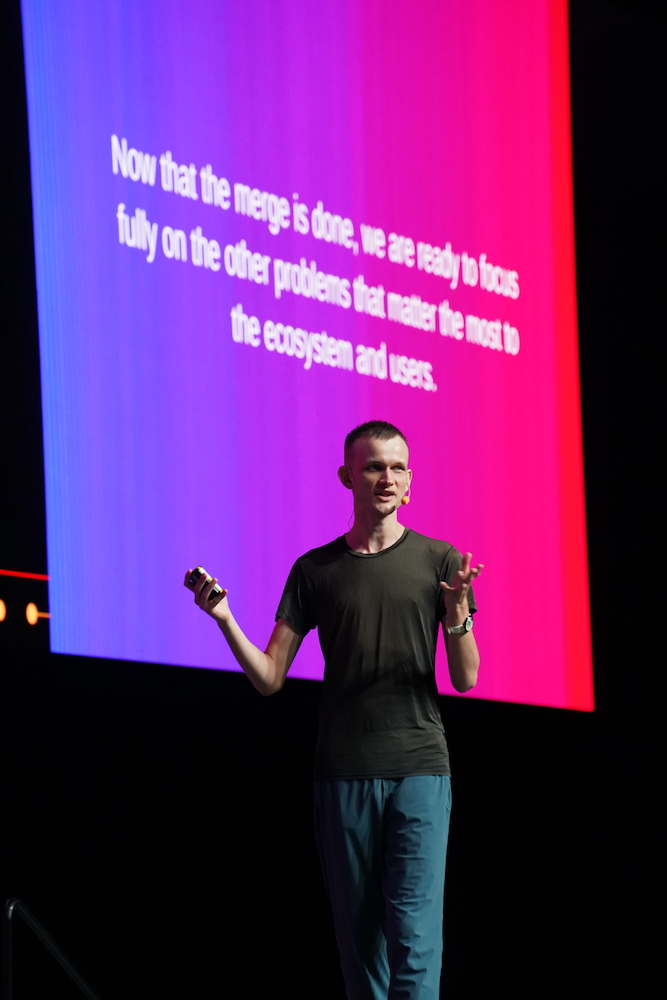On September 15, one of the most significant changes occurred on a layer 1 blockchain network. The Ethereum network, which thus far had operated on a Proof-of-Work (PoW) system, changed to a Proof-of-Stake (PoS) system.
But for many who are only superficially involved in cryptocurrency and blockchain networks, this event probably went down as a historical footnote — some discussion was raised, but other events probably took centrestage.
This was — at least to Ethereum founder Vitalik Buterin — a key moment for the Ethereum blockchain and its future. It marked the success of years of research and work, and was a better way to run the Ethereum blockchain.
At the Singapore Fintech Festival 2022 held earlier this month, Vitalik bought audiences up to date on this change, and explained the thought process and challenges behind what is dubbed ‘the ETH merge’.
What’s the difference between Proof of Work and Proof of Stake?
Vitalik Buterin, founder of Ethereum / Image Credit: Singapore Fintech Festival 2022
In simple terms, a PoW system means that anyone can be a validator on the blockchain to verify transactions. Each validator is constantly searching for an input to output a desired hash, in order to add the new block to the blockchain.
This means that everyone who is mining the cryptocurrency would be using electricity in order to find a valid input, and competing to be the first to find the input. Needless to say, this has resulted in blockchains like Bitcoin, which run on a PoW system, using massive amounts of electricity and drawing the criticism of environmentalists.
In contrast, a PoS system limits the number of validators to the number of people who have staked their cryptocurrency in the system in exchange for the right to become a validator. In this system, validators are chosen at random, before they enter into the computation to find the valid input to add the next block into the blockchain.
This means that less energy is being used, since there is no competition between validators to be the quickest to find a new input for every block. According to Vitalik, the Ethereum blockchain’s energy consumption dropped more than 99 per cent after the merge, because of the shift to the PoS consensus model.
Ethereum Energy Consumption / Image Credit: Digitconomist.net
This is not the only benefit of the new PoS system — the new consensus model also means that Ethereum will be, in theory, more resilient to hacks.
Under a PoW model, a 51 per cent attack would mean that hackers would have to control 51 per cent of all the computing power that is being dedicated to mining bitcoin, before they can validate false transactions with certainty.
With Ethereum’s new PoS model, the 51 per cent attack can still occur. However, hackers would have to control over 51 per cent of the Ethereum that is being staked, in order to approve fraudulent transactions, which would make it extremely expensive to attempt.
Vitalik also pointed out that since the merge, the Ethereum blockchain has seen less forks, and that when a fork happens, the forked chain does not proceed very far before it becomes overwritten.
What does this mean for users as a whole? Well, Vitalik believes that the merge is something that Ethereum will benefit from.
PoW has served Ethereum well, but it has a lot of criticism, and it’s not as secure as it should be. There are issues with centralisation, environmental impact, and much more. Now that the merge is done, Ethereum can focus on its users and on other problems like scalability, user experience, and privacy.
– Vitalik Buterin, co-founder of Ethereum
Ethereum 2.0 wasn’t built in a day
Ethereum 2.0 may only have really reached mainstream attention this year, but for Vitalik, the project has already been several years in the making. In fact, it began eight years ago, starting with a blog post by Vitalik on the idea of having a PoS blockchain.
 The process of developing a PoS system for Ethereum/ Image Credit: Vitalik Buterin
The process of developing a PoS system for Ethereum/ Image Credit: Vitalik Buterin
The next few years were spent theorising on how to actually make a PoS blockchain work for Ethereum, and finally, the publication of a white paper on turning the Ethereum Blockchain into a PoS blockchain from a PoW blockchain.
It was only in 2018 that development began on the software that would eventually be used to run the Beacon chain. It would take another two and half years for the Beacon chain to launch, and another two years for the Beacon chain to merge into the Ethereum mainnet, and for the merge to be completed.
This process, as Vitalik explained, was a long and drawn out process. When he started the process off with the blog post, he had no idea at the time whether a PoS system would really work.
At the time, it really was just an idea that he wanted to explore and keep looking at, but that if it were found to be viable, the Ethereum blockchain might indeed switch to a PoS system in the future.
After the merge, where does Ethereum stand within crypto?
Despite the change, Vitalik doesn’t believe that Ethereum will push Bitcoin out of the market. Instead, both cryptocurrencies have different appeals, and therefore they have different communities that are backing them up.
Regardless, Vitalik believes that Ethereum will continue to evolve, and that he is not yet done making changes and improvements to the Ethereum ecosystem.
One of the possible avenues that Vitalik is exploring is the growing ability of Ethereum to provide a proof of identity for its users. According to him, Ethereum’s growth meant that it now has a more reliable identity stack, and Ethereum has been taking advantage of this.
For a start, Ethereum allows users to own their username, and tie it to their profile through the Ethereum Name Service. This has simplified payments for Ethereum users since they no longer have to copy and paste a long wallet address, since the unique name is tied to the wallet.
 Image Credit: Ethereum Name Service
Image Credit: Ethereum Name Service
This offers benefits beyond just payments. Dapps now allow you to sign in with Ethereum, and since user experience is one of the issues that Vitalik believes cryptocurrencies in general can improve on, the ability to sign in with an Ethereum wallet or account can greatly simplify the process for many new entrants.
 Image Credit: CryptoTicker
Image Credit: CryptoTicker
With all the talk about how Ethereum is consistently getting better and how Vitalik is helping Ethereum grow, it would be helpful to stop and consider what the merge actually means for consumers.
While Ethereum has certainly gone through a momentous shift from PoW to PoS, this is not something that necessarily impacts the everyday consumer when they buy crypto or use it to pay for something.
We should also note that PoS staking means that power is more centralised — validators who stake large amounts of Ethereum have a higher chance of being able to validate new blocks — and this means that they are prime targets for any unscrupulous actors. PoS is not exactly unhackable, as the Axie Infinity hack shows.
At least for now, the changes to Ethereum are confined to those who validate the blockchain. That being said, Vitalik has promised that the blockchain will continue to improve, and has already pointed out the areas where he is preparing to make changes.
These changes are the ones that are of greater concern to consumers — they deal with user experience, transaction speed, and privacy.
Ethereum is already a huge player within the crypto ecosystem and with these changes, Ethereum seems to be investing fully in getting new players on board to expand their ecosystem.
Featured Image Credit: Singapore Fintech Festival 2022
Source by vulcanpost.com






























